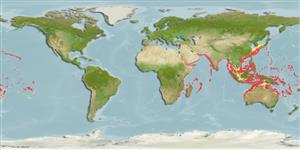>
Eupercaria/misc (Various families in series Eupercaria) >
Lutjanidae (Snappers) > Etelinae
Etymology: Etelis: Greek, etelis, -idos = a fish, perhaps the fish Sparus aurata (Ref. 45335).
More on author: Valenciennes.
Environment: milieu / climate zone / profondeur / distribution range
Écologie
marin récifal; profondeur 45 - 400 m (Ref. 9821), usually 90 - 400 m (Ref. 9821). Deep-water; 38°N - 32°S, 29°E - 139°W
Indo-Pacific: East Africa eastward to the Hawaiian Islands, north to Sea of Japan, south to Australia (Queensland and New South Wales) and Lord Howe Island; off Kermadec Islands, northeast of New Zealand (Ref. 9821). Reported from the Marquesas (Ref. 114223). The name Etelis carbunculus has been misapplied to this species by some previous authors.
Length at first maturity / Taille / Poids / Âge
Maturité: Lm 66.3, range 52 - ? cm
Max length : 120 cm TL mâle / non sexé; (Ref. 5484); common length : 50.0 cm SL mâle / non sexé; (Ref. 9821)
Épines dorsales (Total) : 10; Rayons mous dorsaux (Total) : 11; Épines anales: 3; Rayons mous anaux: 8. Interorbital space flat. Maxilla covered with scales. Dorsal and anal fin bases without scales. Upper caudal lobe becoming greatly elongated with increased growth. Scale rows on back parallel with lateral line. Back and upper sides deep pink to red; lower sides and belly pink; fins pink to red.
Body shape (shape guide): fusiform / normal; Cross section: oval.
Adults inhabit rocky bottoms (Ref. 30573) of the continental shelf and continental slope (Ref. 75154). Benthopelagic (Ref. 58302). Feed on small fishes, squids and crustaceans (Ref. 30573). Considered an important food fish in some areas. Marketed fresh and frozen (Ref. 9987). Highly valued for the quality of its flesh (Ref. 11888). Mnimum depth from Ref. 089972.
Life cycle and mating behavior
Maturité | Reproduction | Frai | Œufs | Fécondité | Larves
Allen, G.R., 1985. FAO Species Catalogue. Vol. 6. Snappers of the world. An annotated and illustrated catalogue of lutjanid species known to date. FAO Fish. Synop. 125(6):208 p. Rome: FAO. (Ref. 55)
Statut dans la liste rouge de l'IUCN (Ref. 130435: Version 2025-1)
Menace pour l'homme
Harmless
Utilisations par l'homme
Pêcheries: hautement commercial; pêche sportive: oui; appât: occasionally
Outils
Articles particuliers
Télécharger en XML
Sources Internet
Estimates based on models
Preferred temperature (Réf.
123201): 9.9 - 24.8, mean 17 °C (based on 829 cells).
Phylogenetic diversity index (Réf.
82804): PD
50 = 0.5312 [Uniqueness, from 0.5 = low to 2.0 = high].
Bayesian length-weight: a=0.01660 (0.01347 - 0.02044), b=2.95 (2.89 - 3.01), in cm total length, based on LWR estimates for this species (Ref.
93245).
Niveau trophique (Réf.
69278): 4.4 ±0.2 se; based on diet studies.
Résilience (Réf.
120179): Faible, temps minimum de doublement de population : 4,5 à 14 années (K=0.12; tmax=20).
Fishing Vulnerability (Ref.
59153): Moderate to high vulnerability (45 of 100).
🛈
Nutrients (Ref.
124155): Calcium = 5.05 [2.53, 11.76] mg/100g; Iron = 0.208 [0.098, 0.492] mg/100g; Protein = 18.9 [17.0, 20.7] %; Omega3 = 0.224 [0.114, 0.423] g/100g; Selenium = 12.7 [5.2, 31.1] μg/100g; VitaminA = 35.8 [6.8, 215.2] μg/100g; Zinc = 0.242 [0.151, 0.381] mg/100g (wet weight);
